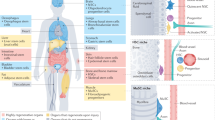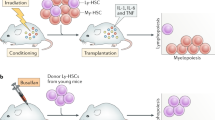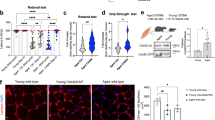Abstract
Ageing in multicellular organisms typically involves a progressive decline in cell replacement and repair processes, resulting in several physiological deficiencies, including inefficient muscle repair, reduced bone mass, and dysregulation of blood formation (haematopoiesis). Although defects in tissue-resident stem cells clearly contribute to these phenotypes, it is unclear to what extent they reflect stem cell intrinsic alterations or age-related changes in the stem cell supportive microenvironment, or niche. Here, using complementary in vivo and in vitro heterochronic models, we show that age-associated changes in stem cell supportive niche cells deregulate normal haematopoiesis by causing haematopoietic stem cell dysfunction. Furthermore, we find that age-dependent defects in niche cells are systemically regulated and can be reversed by exposure to a young circulation or by neutralization of the conserved longevity regulator, insulin-like growth factor-1, in the marrow microenvironment. Together, these results show a new and critical role for local and systemic factors in signalling age-related haematopoietic decline, and highlight a new model in which blood-borne factors in aged animals act through local niche cells to induce age-dependent disruption of stem cell function.
This is a preview of subscription content, access via your institution
Access options
Subscribe to this journal
Receive 51 print issues and online access
$199.00 per year
only $3.90 per issue
Buy this article
- Purchase on Springer Link
- Instant access to full article PDF
Prices may be subject to local taxes which are calculated during checkout





Similar content being viewed by others
References
Caspari, R. & Lee, S. H. Older age becomes common late in human evolution. Proc. Natl Acad. Sci. USA 101, 10895–10900 (2004)
Rossi, D. J., Jamieson, C. H. & Weissman, I. L. Stems cells and the pathways to aging and cancer. Cell 132, 681–696 (2008)
Rossi, D. J. et al. Cell intrinsic alterations underlie hematopoietic stem cell aging. Proc. Natl Acad. Sci. USA 102, 9194–9199 (2005)
Morrison, S. J. et al. The aging of hematopoietic stem cells. Nature Med. 2, 1011–1016 (1996)
Liang, Y., Van Zant, G. & Szilvassy, S. J. Effects of aging on the homing and engraftment of murine hematopoietic stem and progenitor cells. Blood 106, 1479–1487 (2005)
Rossi, D. J. et al. Deficiencies in DNA damage repair limit the function of haematopoietic stem cells with age. Nature 447, 725–729 (2007)
Janzen, V. et al. Stem-cell ageing modified by the cyclin-dependent kinase inhibitor p16INK4a . Nature 443, 421–426 (2006)
Tothova, Z. et al. Foxos are critical mediators of hematopoietic stem cell resistance to physiologic oxidative stress. Cell 128, 325–339 (2007)
Mayack, S. R. & Wagers, A. J. Osteolineage niche cells initiate hematopoietic stem cell mobilization. Blood 112, 519–531 (2008)
Zhang, J. et al. Identification of the haematopoietic stem cell niche and control of the niche size. Nature 425, 836–841 (2003)
Calvi, L. M. et al. Osteoblastic cells regulate the haematopoietic stem cell niche. Nature 425, 841–846 (2003)
Jones, D. L. & Wagers, A. J. No place like home: anatomy and function of the stem cell niche. Nature Rev. Mol. Cell Biol. 9, 11–21 (2008)
Wagers, A. J. & Conboy, I. M. Cellular and molecular signatures of muscle regeneration: current concepts and controversies in adult myogenesis. Cell 122, 659–667 (2005)
Wagers, A. J. et al. Little evidence for developmental plasticity of adult hematopoietic stem cells. Science 297, 2256–2259 (2002)
Sherwood, R. I. et al. Isolation of adult mouse myogenic progenitors: functional heterogeneity of cells within and engrafting skeletal muscle. Cell 119, 543–554 (2004)
Eggan, K. et al. Ovulated oocytes in adult mice derive from non-circulating germ cells. Nature 441, 1109–1114 (2006)
Balsam, L. B. et al. Haematopoietic stem cells adopt mature haematopoietic fates in ischaemic myocardium. Nature 428, 668–673 (2004)
Wright, D. E. et al. Physiological migration of hematopoietic stem and progenitor cells. Science 294, 1933–1936 (2001)
Osawa, M. et al. Long-term lymphohematopoietic reconstitution by a single cd34-low/negative hematopoietic stem cell. Science 273, 242–245 (1996)
Ema, H. et al. Adult mouse hematopoietic stem cells: purification and single-cell assays. Nature Protocols 1, 2979–2987 (2007)
Wilson, A. & Trumpp, A. Bone-marrow haematopoietic-stem-cell niches. Nature Rev. Immunol. 6, 93–106 (2006)
Arai, F., Hirao, A. & Suda, T. Regulation of hematopoietic stem cells by the niche. Trends Cardiovasc. Med. 15, 75–79 (2005)
Morrison, S. J. et al. Identification of a lineage of multipotent hematopoietic progenitors. Development 124, 1929–1939 (1997)
Musarò, A. et al. Localized Igf-1 transgene expression sustains hypertrophy and regeneration in senescent skeletal muscle. Nature Genet. 27, 195–200 (2001)
Fisher, M. C. et al. Role of IGFBP2, IGF-I and IGF-II in regulating long bone growth. Bone 37, 741–750 (2005)
Wang, Y. et al. IGF-I receptor is required for the anabolic actions of parathyroid hormone on bone. J. Bone Miner. Res. 22, 1329–1337 (2007)
Welniak, L. A. et al. Effects of organ-specific loss of insulin-like growth factor-I production on murine hematopoiesis. Biol. Blood Marrow Transplant. 10, 32–39 (2004)
Gibson, L. F., Piktel, D. & Landreth, K. S. Insulin-like growth factor-1 potentiates expansion of interleukin-7-dependent pro-b cells. Blood 82, 3005–3011 (1993)
Brack, A. S. et al. Increased Wnt signaling during aging alters muscle stem cell fate and increases fibrosis. Science 317, 807–810 (2007)
Liu, H. et al. Augmented Wnt signaling in a mammalian model of accelerated aging. Science 317, 803–806 (2007)
Kuro-o & M Klotho as a regulator of oxidative stress and senescence. Biol. Chem. 389, 233–241 (2008)
Guarente, L. & Kenyon, C. Genetic pathways that regulate ageing in model organisms. Nature 408, 255–262 (2000)
Kiel, M. J. et al. Slam family receptors distinguish hematopoietic stem and progenitor cells and reveal endothelial niches for stem cells. Cell 121, 1109–1121 (2005)
DiGirolamo, D. J. et al. Mode of growth hormone action in osteoblasts. J. Biol. Chem. 282, 31666–31674 (2007)
Fulzele, K. et al. Disruption of the insulin-like growth factor type 1 receptor in osteoblasts enhances insulin signaling and action. J. Biol. Chem. 282, 25649–25658 (2007)
Nakasaki, M. et al. IGF-I secreted by osteoblasts acts as a potent chemotactic factor for osteoblasts. Bone 43, 869–879 (2008)
Cornish, J. et al. Shared pathways of osteoblast mitogenesis induced by amylin, adrenomedullin, and IGF-1. Biochem. Biophys. Res. Commun. 318, 240–246 (2004)
Acknowledgements
This work was supported in part by funding from the Burroughs-Welcome Fund, WM Keck Foundation, Glenn Foundation, and National Institutes of Health (NIH) 1 DP2 OD004345-01 (to A.J.W.), by fellowships from the NIH (T32DK07260-29) and the Iacocca Foundation (to S.R.M.), and by the Joslin Diabetes Center DERC (P30DK036836). We thank J. LaVecchio and G. Buruzula for expert cell sorting, C. J. Luckey for anti-IGF-1 antibody, and L. Zon, R. Lee, D. Rossi, L. P. Kane, S. Lowe and C. Dall’Osso for helpful advice and critical reading of the manuscript. The content is solely the responsibility of the authors and does not necessarily represent the official views of the NIH.
Author Contributions S.R.M. and A.J.W. designed and interpreted experiments. S.R.M. performed and analysed the experiments. J.L.S. assisted in parabiosis procedures, and F.S.K. assisted in LT-HSC analysis from parabiotic mice.
Author information
Authors and Affiliations
Corresponding author
Ethics declarations
Competing interests
The authors declare no competing financial interests.
Supplementary information
Supplementary Information
This file contains Supplementary Figures S1-S8 with Legends and Supplementary Table 1. (PDF 902 kb)
Rights and permissions
About this article
Cite this article
Mayack, S., Shadrach, J., Kim, F. et al. Systemic signals regulate ageing and rejuvenation of blood stem cell niches. Nature 463, 495–500 (2010). https://doi.org/10.1038/nature08749
Received:
Accepted:
Published:
Issue Date:
DOI: https://doi.org/10.1038/nature08749
This article is cited by
-
Prostaglandin E2 Enhances Aged Hematopoietic Stem Cell Function
Stem Cell Reviews and Reports (2021)
-
Vampires 2.0? The ethical quandaries of young blood infusion in the quest for eternal life
Medicine, Health Care and Philosophy (2020)
-
Ascorbic acid inhibits senescence in mesenchymal stem cells through ROS and AKT/mTOR signaling
Cytotechnology (2018)
-
An epigenetic clock controls aging
Biogerontology (2016)
-
Nutraceutical intervention reverses the negative effects of blood from aged rats on stem cells
AGE (2015)
Comments
By submitting a comment you agree to abide by our Terms and Community Guidelines. If you find something abusive or that does not comply with our terms or guidelines please flag it as inappropriate.



